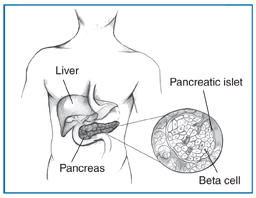Archive for February 2016
Early Signs of Diabetes
Diabetes is one of the sneakiest diseases of our time. 1 in 3 people with type 2 diabetes is unaware of having it and may unwillingly ignore thy symptoms for as long as months or even years. And, even if people do notice the early signs, the awareness is low, that they won’t realize what these symptoms mean for their health.
This fact makes diabetes extremely dangerous. Every delay in diagnosis and treatment increases the chance of increased suffering – for example, a delay of just 3 years increases the risk of a heart disease by 29%.
– for example, a delay of just 3 years increases the risk of a heart disease by 29%.
And if early detected, the prognosis can be much more optimistic and the negative impact of diabetes on long-term health can be much lower. This is why it is important to do everything to control potential diabetes before it starts to control you.
From the medical point of view, diabetes is used to name a situation in which glucose (blood sugar) levels are elevated for a much longer time than usual. This is typically true both for children as well as adults. There are two different diabetes types, which differ primarily in the development time of the disease.
In type 1 diabetes, the symptoms develop most of the time very quickly, with the condition being found out in an emergency setting. On the other hand, in type 2 diabetes the progress of the disease is quite slow and symptoms can build up gradually. As said before, some don’t even notice the early symptoms until it can be too late.
The early signs of diabetes vary and are as listed below:
-
One of the most prevalent symptoms is increased urination
The average person goes to the bathroom 4 to 7 times throughout a day. If you noticed you need to go way more often than that, you may suffer from Polyuria, a common condition which is one of the symptoms of diabetes. If you wake up in the middle of the night to go to the toilet, even if you went there just before going to bed, this could be another warning that you might have an elevated level of blood sugar.
-
Constant thirst is another common early sign of diabetes
 An average recommended water intake for an adult is one half gallon per day. If your intake exceeds that and averages twice that amount and more, and if you begin to feel thirsty right after you drink water or any other drink, you should definitely check yourself for diabetes. In fact, #1 and #2 are related as if you keep drinking, it’s quite obvious you’ll have to urinate more.
An average recommended water intake for an adult is one half gallon per day. If your intake exceeds that and averages twice that amount and more, and if you begin to feel thirsty right after you drink water or any other drink, you should definitely check yourself for diabetes. In fact, #1 and #2 are related as if you keep drinking, it’s quite obvious you’ll have to urinate more.
-
Continuous hunger (even right after a meal)
A sign similar to the last one, but this time, it’s all about hunger. If you feel empty even right after having a decent meal, this may be a symptom of blood sugar problems. Your brain may incorrectly keep sending you signals that you should eat, even if you have just eaten, what will make you feel constantly hungry.
-
Rapid and unexpected weight loss
Even if you eat a lot, if you suffer from diabetes you may rapidly lose weight, in amounts not adequate for a standard process of weight losing and gaining – usually between 11 to 22 lbs in a short time frame (a few weeks or a month or two). This is more common sign of type 1 diabetes, in which the metabolism of sugar can be shut down in a short time.
-
Skin problems including dry or itchy skin
Irritated, overly itchy or dry skin can be a sign of hormonal problems and elevated sugar level. Sometimes, the skin gets not only dry but also darkens, especially around the neck or armpits. This is known as Acanthosis Nigricans.
Experienced ‘eye floaters’ or blurred and distorted vision are common symptoms of developing diabetes. Luckily, because this problem is related to high blood sugar levels, once they are corrected it is usually reversed and the vision goes back to normal.
-
Numbness or tingling (known also as pins and needles) present in hands or feet
If your limbs get numb or tingling (especially hands or feet), most commonly right after you wake up (you may feel a burning sensation) this can be an early sign of your diabetes.
-
Wounds and cuts take a long time to heal
If your blood sugar level is high, even a small cut or bruise can take a long time to heal – especially if they have appeared on body parts further from the heart such as your feet or hands.
-
If you keep feeling tired or weak you may suffer from diabetes.
Because sugar in your blood can elevate or decrease your mood and the feeling of fatigue, unmanaged diabetes can make you feel lousy, tired and, in fact, lazy very easily. Sometimes this sign is so strong that it makes you too weak to even take care of your regular everyday activities.
Now think for a minute and check – can you notice any of the listed symptoms?
Visit your doctor if you believe you have any of the above symptoms and immediately do a test to determine your blood sugar level. The most basic one is a non-invasive finger prick test just to get an overall idea of your condition. If diagnosed early, these symptoms may be stopped from turning into more harmful and permanent.
Diabetic Ketoacidosis
Diabetic Ketoacidosis (DKA) is a condition-affecting individual with diabetes and it can be very serious. When a diabetic’s body is unable to utilize glucose, i.e. sugar, as a source of fuel due to a lack of insulin or the presence of none at all, DKA can occur. At that point the body starts burning fat for fuel instead of glucose and the poisonous ketone chemicals start building up in the blood and urine.
Symptoms of Diabetic Ketoacidosis include:
- Decrease in alertness
- Face flushing

- Dry mouth and skin
- Rapid deep breathing
- Breath that smells fruity
- Frequent thirst or urination lasting one day or more
- Stomach pains
- Nausea
- Vomiting
- Headaches
- Muscle aching or stiffness
In some cases, Diabetic Ketoacidosis can be the first sign that undiagnosed diabetics receive, but it could also occur in an individual who has already received a diabetes diagnosis. In addition, there are a number of circumstances that could cause DKA in type 1 diabetics, as well as in type 2 diabetics although less often, including:
- Surgery
- Injury
- Infection
- Serious illness
- Missed insulin dosage
Generally, ketone testing of a blood or urine sample is utilized when DKA is suspected and then the measurement of beta-hydroxybutyrate in the blood if there are ketones in the urine.
Additional DKA tests that are available include:
- Blood pressure
- Blood glucose
- Basic metabolic panel
- Arterial blood gas
If left untreated, Diabetic Ketoacidosis can result in kidney failure, cerebral edema or cardiac arrest. Any one of these conditions could lead to death, so it’s critical that you call 911 or head for the ER if you or a diabetic loved one experiences symptoms, including fruity breath, difficulty breathing, a decrease in consciousness, nausea or vomiting.
Most patients who have diabetes are advised by their doctor about identifying the Diabetic Ketoacidosis warning signs by using a glucose meter or urine strips. If you perform one of these tests and find ketones, it’s important to call your health care provider immediately and then be sure that you’re following all of the instructions that you receive. The majority of patients are found to be responding in 24 hours or less, although in some cases, recovery could take longer.
If you are diabetic, learning how to recognize the symptoms of Diabetic Ketoacidosis is crucial to your health and well being. And, insulin pump users should check regularly to ensure that your insulin flows through your tubing and that it isn’t disconnected kinked or otherwise blocked.
What Causes Diabetes?
Diabetes is a common disease that is brought about by many different factors. Diabetics also suffer from high blood pressure or hyperglycemia as it is medically called.
This condition is a disorder of the metabolic system. This is because it starts developing the moment the body cannot produce enough insulin or use it up effectively. Sometimes it can also be due to both of these scenarios. Where exactly is this insulin produced? The pancreas is responsible for its production. It has clusters of cells referred to as islets whose constituent beta cells make insulin.
Given that beta cells produce insulin, it is upon the body to use it up. However, it is also possible that these cells do not produce enough insulin. When this happens, one can either be diagnosed with pre diabetes or diabetes.
Pre diabetes refers to a condition where the average blood glucose levels are higher than normal but not too extreme to be diagnosed as diabetes. This is different from diabetes because the body’s cells still have some energy.
Effects of Diabetes
When an individual has had diabetes for a long time, the high blood glucose damages nerves and blood vessels. This can lead to complications like heart diseases, kidney diseases, stroke, blindness and even amputations in extreme cases. People with diabetes are also susceptible to other diseases, decrease and even loss of motion, depression, aging and pregnancy issues. What causes diabetes? While no one can pinpoint the definite cause of this condition, scientists attribute it to genetics and the environment.
Types of Diabetes
There are two principal kinds of diabetes; type 1 and type 2. The other common one only develops in pregnant women, and it is known as gestational diabetes. Even though type 1 and 2 are different, there are also people who exhibit symptoms of both of them.
Causes of Type 1 Diabetes
Type 1 diabetes results from low production of insulin. This happens when the beta cells are damaged normally by the body’s immune system. This makes it an autoimmune disease. The destruction can go on for several years although someone can start showing the symptoms after a very short period. Even though it attacks people of all ages, it is prevalent in children and young adults. This is actually the reason it also called juvenile diabetes or insulin-dependent diabetes mellitus.
Adults who are around 30 years of age also tend to develop a form of type 1 diabetes called latent autoimmune diabetes in adults. It develops slowly and even though those individuals still produce insulin, they will need insulin shots later on in life.
Heredity and Diabetes
A person’s genetic makeup has a very big role to play when it comes to developing type 1 diabetes. Parents pass down genes to their offspring, and it is these genes that influence susceptibility to type 1 diabetes. There are gene variants that are responsible for the formation of proteins called human leukocyte antigens (HLA). It is the proteins produced by HLA genes that dictate whether the body will turn against some cells thinking they are foreign objects or not. Some variants of this gene also determine whether a person will have type 1 diabetes.
HLA genes are not the only one responsible for type 1 diabetes. There are also many other risk genes and gene regions that cause the condition. Luckily, genetic testing can identify the types of HLA genes that one carries and tell if they can lead to diabetes. Scientists are also busy trying to figure out how genetic testing results can be used for prevention and treatment of type 1 diabetes.
Autoimmune Destruction of Beta Cells
 T cells attack and damage beta cells in type 1 diabetes. When this is happening, someone cannot easily tell and diagnosis only come in late when the cells have been destroyed, and the patient has to start using insulin shots. Studies have shown that the insulin itself can actually be a trigger for the attack on beta cells.
T cells attack and damage beta cells in type 1 diabetes. When this is happening, someone cannot easily tell and diagnosis only come in late when the cells have been destroyed, and the patient has to start using insulin shots. Studies have shown that the insulin itself can actually be a trigger for the attack on beta cells.
Environmental Factors
Foods, viruses, and toxins are also common environmental factors that cause type 1 diabetes. While the exact way in which they do this has not been established, some studies indicate that they trigger the autoimmune destruction of beta cells. Viruses can also cause type 1 diabetes although many people are also diagnosed with this condition after a viral infection.
Breastfeeding practices for infants are also believed to cause diabetes. For example, infants who breastfeed regularly have sufficient amounts of vitamin D and are less susceptible to type 1 diabetes. On the other hand, earlier exposure to cow’s milk and cereal proteins increases the susceptibility to type 1 diabetes.
Pre Diabetes Diet
The very idea of contracting type 2 diabetes is frightening. It becomes even more so if you believe that you really don’t have any control over whether or not you contract this disease. However, that sentiment could not be further from the truth. Make no mistake about it, the numbers are staggering. It is thought that in a matter of a few decades, one in three individuals will have type 2 diabetes.
Right now, there are millions of Americans walking around with the disease who don’t even know it yet. With that being said, a pre diabetes diet can change everything. The question is, how do you follow an effective pre diabetes diet and what steps do you need to take.
There are important key factors to following a diet that is designed specifically to help you keep type 2 diabetes at bay. Of course, these seven steps have to be incorporated with an effective exercise program in order to work their best. This means that you need to be getting both cardiovascular exercise and weight training routines in each week, preferably for at least 30 minutes a day 3 to 4 times weekly.
However, the biggest issue is to start moving so if you are not exercising at all, it is best to start out small and then gradually increase both the intensity and the amount of time that you spend doing it. Remember, a little exercise is better than none and you have to start somewhere. It is always okay to start with an easier and less stressful routine and then work your way up to something that is more effective over time.
Below are the seven key steps that you should be following if you want to create a diet that will help you keep your blood sugar levels low.
1) Stop drinking sugary drinks.
This is one of the biggest issues when it comes to staving off type 2 diabetes in America today. Sugar is added to all kinds of drinks. Unless you drink tea and coffee without sugar and the only other thing you drink is water, there is every chance that you are consuming far too much sugar from your drinks alone. This is true even if you have a habit of adding flavored powder to your water, as they contain high amounts of sugar. Even diet soda is not entirely safe. Your best bet is to become more aware of how much sugar is in your favorite drinks and then cut out everything that has excessive levels.
2) Portion control is key.
If your waistline is expanding, there is every chance that your blood sugar levels are going up as well. Learning to control your  portions effectively is one of the most important things you can do to live a healthier lifestyle, especially if you have a tendency to eat starchy foods such as white bread, potatoes and white rice. Choose your foods carefully, eat in moderation and be careful to measure accurate portions as opposed to overeating. All of this will help you keep your blood sugar levels in check.
portions effectively is one of the most important things you can do to live a healthier lifestyle, especially if you have a tendency to eat starchy foods such as white bread, potatoes and white rice. Choose your foods carefully, eat in moderation and be careful to measure accurate portions as opposed to overeating. All of this will help you keep your blood sugar levels in check.
3) Consume more fiber.
When you eat more fiber, you feel full so you eat less. More importantly, fiber helps to keep your digestive system active, thereby making it easier for the body to push waste and toxins through as opposed to allowing everything to stagnate. Fiber can be found in fruits and vegetables, as well as beans. If you are still not getting enough fiber, you can take an all natural fiber supplement as long as you make sure that sugar is not added to it.
4) Eat less fat.
If you are going to consume red meat, make sure that the cuts are lean. In addition, it is important to trim any fat away that does exist before you prepare it. White meat turkey and chicken without the skin are excellent options, as is fish. When you are preparing your meal, make sure that you do not add fat in by frying the food. Find more creative ways to prepare it. It will both taste better and be healthier for you.
5) Drink alcohol in moderation.
If you consume alcohol, it is important to keep the amount down to minimal levels. Men can typically consume 2 drinks per day while women must limit their alcohol intake to one drink. It is also important to keep in mind that portion control is important here as well. One drink typically consists of a 12 ounce can of beer or a five ounce glass of wine, but no more. Hard alcohol gives you even less wiggle room. Typically, one shot glass is all that you should consume.
6) Lean protein is the answer.
You already know that you should be consuming less fat, but when you consume lean protein instead of eating food with a high fat content, you give your body the nutrition that it needs without depriving yourself of anything and you simultaneously do what you can to keep your blood sugar levels from rising to potentially dangerous heights. Therefore, you should always look for protein from sources like fish, nuts or beans as opposed to turning to meat with a high fat content.
7) Hydrate your body with water.
One of the most important things in keeping your blood sugar levels where they belong is to stay properly hydrated. However, it is equally important that you do not consume sugary drinks, such as sports drinks, on a regular basis. Instead, make sure that you are drinking plenty of water. Generally speaking, it is important to drink approximately 8 to 10 eight ounce glasses of water each day. If you are especially active, you may want to drink more.
equally important that you do not consume sugary drinks, such as sports drinks, on a regular basis. Instead, make sure that you are drinking plenty of water. Generally speaking, it is important to drink approximately 8 to 10 eight ounce glasses of water each day. If you are especially active, you may want to drink more.
By following these steps, you can start to take control of your own health and stop worrying about type 2 diabetes. Granted, following all of these steps may be an adjustment in your lifestyle, but it is well worth the effort. Furthermore, the dividends that these changes can pay go far beyond any inconvenience that you may experience at first.
Lally Naturals Blood Sugar Support supplement is now available in two sizes.
Statin Users at Increased Risk of Developing Diabetes and Other Dangerous Conditions
According to a study conducted over a 10 year period and published in the May 2015 Journal of General Internal Medicine, statin users have double the risk of developing diabetes than individuals who didn’t take statins, a common medication prescribed to reduce bad cholesterol levels and lower the risk of heart problems. In addition, they an astounding 250 percent more likely to develop diabetes related complications, particularly eye, kidney, and nerve damage [1].
The study was conducted to “examine the association between statin use and new-onset diabetes, diabetic complications, and overweight/obesity in a cohort of healthy adults.” After comparing statin users and nonusers over the course of a decade, researchers determined that statin-users were more likely to be diagnosed with diabetes, diabetic complications, and obesity than similar nonuser in a group of healthy adults.
Of further concern, the research also indicates that statins have a number of potentially debilitating side effects, including impaired memory, fatigue, muscle aches and pain, depression, and stroke. According to Professor Ishak Mansi, who led the study and serves as a heart specialist at the University of Texas, “Our findings are alarming.” He went on to explain that this was the first time a correlation had been found between statin use and diabetes.
In regards to people diagnosed with heart disease, he said, “I am sceptical [sic] about the prescribing guidelines for people at lower risk… I am concerned about the long term effects on the huge population of healthy people on these drugs who continue for many years.”
According to Mansi, the study doesn’t definitively indicate that diabetes cause diabetes, nor do the results mean that someone taking statins should stop taking the medication [2]. In fact, Mansi refers to statins as a “cornerstone in treatment of cardiovascular diseases.” However, he does suggest that anyone taking statins should be aware of the risk and use this as motivation to give up smoking or losing weight, both of which have been shown to stress the heart.
Additional Health Risks Found
Unfortunately for statin users, this isn’t the first time studies have found clear evidence that statins are dangerous. According to an article published in the July 2015 issue of the American Journal of Physiology – Cell Physiology, stains “deactivate” the stem cells in the body that are response for cellular repairs and side effects may include cataracts, loss of memory, muscle aches and pain, liver dysfunction, and fatigue [3].
Professor Reza Izadpanah, a stem cell biologist at Tulane University in New Orleans and lead author of the above study also reported “Our study shows statins may speed up the aging process.”
Yet Statins Continue to be Prescribed
Despite the fact that statins have been found to increase a user’s risk of developing a variety of dangerous health conditions, they are prescribed to approximately 100 million individuals all over the world every year. Why? For pharmaceutical companies, statins can generate tens of billions of dollars in a single year [3].
In today’s world, our health is going from bad to worse, yet doctors continue to write prescriptions without regard to potential negative effects. If we question the possibility of side effects, we’re often told to “give it time” or prescribed another type of medication in the same family and encouraged to “hang in there and see how this one works.”
It goes without saying that, as people, we deserve better than this. If you are taking statins and develop diabetes, natural blood sugar supplements can help your condition stay under control.
[1] http://www.newstarget.com/2016-02-04-statins-double-the-risk-of-developing-diabetes-and-diabetic-complications-according-to-ten-year-long-study.html c
[2] http://www.research.va.gov/currents/spring2015/spring2015-19.cfm
[3] http://www.naturalnews.com/051363_statin_drugs_accelerated_aging_side_effects.html#

